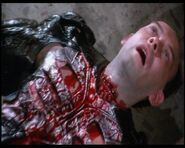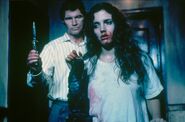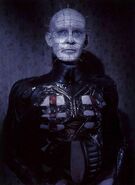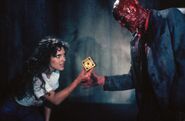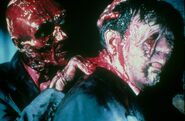| “ | No tears, please. It's a waste of good suffering | „ |
| ― Pinhead |
Hellraiser is a 1987 British horror film exploring the themes of sadomasochism, pain as a source of pleasure, and morality under duress and fear. It is based on the critically acclaimed novella The Hellbound Heart by Clive Barker, who also wrote the screenplay and directed the film. In the UK, the film is titled Clive Barker's Hellraiser. It is the first film in the Hellraiser series. Nine subsequent sequels have followed. A reboot of the series came about in 2022.
Plot[]
Somewhere in Morocco, an impulsive and violent man named Frank Cotton (Sean Chapman) purchases an antique puzzle box from a dealer (James Hong). Back at his house in London, England, Frank solves the puzzle box and hooked chains immediately fly out of the box and tear into his flesh. Demons called Cenobites from another realm appear to inspect Frank's remains. Their leader, "Pinhead", (Doug Bradley) picks up the box and twists it back into its original state, and the room also returns to normal.
Frank's brother Larry (Andrew Robinson) soon moves into Frank's abandoned house with his second wife, Julia (Clare Higgins), who previously had an affair with Frank. They assume that Frank is off on one of his nefarious adventures. Larry's teenage daughter, Kirsty Cotton (Ashley Laurence), chooses not to live with her stepmother and moves into her own place. After cutting his hand on a nail (while moving a mattress), Larry goes upstairs to the room where Frank was killed and his blood falls on the floor. It mysteriously disappears through the floorboards, and Frank's soul uses this blood as nourishment to partially regenerate his body. Later, Frank (Oliver Smith) convinces Julia to help restore him to his full physical form. Julia succumbs to Frank's entreaties and agrees to help him by seducing men and luring them up to the empty attic where Frank hides. After having Julia murder them, Frank drains them of their blood, which allows him to further regenerate his body. Frank tells Julia about the puzzle box (which he still possesses) and explains that by reclaiming his body he has broken his deal with the Cenobites. He wants to restore himself and then leave with Julia before the Cenobites find him.
Kirsty eventually catches Julia bringing a strange man home and sneaks into the house to investigate. In the attic Julia bludgeons the man, allowing Frank to feast on his body. Kirsty approaches the attic unaware of what's happening within. Suddenly, the bloody man stumbles out of the attic, soon followed by the skinless Frank who confronts Kirsty. Before Frank can grab her, Kirsty seizes the puzzle box. When she realizes it holds value for Frank, she throws it out the window and escapes from the house, picking up the box off the ground as she flees. A disoriented Kirsty collapses in the street and awakens in the hospital. She tells herself it all was a terrible dream, until the doctors hand her the puzzle box. Kirsty begins to play with the puzzle box and it tricks her into solving it. The walls of her hospital room open a dimensional door and Kirsty encounters the Cenobites. Pinhead tells Kirsty that she has summoned them, and therefore they must take her to Hell. She begs them to spare her, offering to lead them to Frank in exchange for her freedom. The Cenobites warn her against attempting deception, with Pinhead uttering his famous line "we'll tear your soul apart."
Kirsty escapes the hospital and races to her father's home to warn him about Frank. Larry informs Kirsty that Frank has been taken care of, and Julia shows Kirsty a bloody body in the attic. The Cenobites reappear, demanding the man responsible for this death. Kirsty believes they want her father and she runs to warn him. However, she soon realizes that Frank has murdered her father and stolen his skin and worn it like a suit to fool Kirsty into believing that he was her father.
Frank (now as Andrew Robinson) attacks Kirsty, accidentally stabbing Julia in the process. Frank then drains Julia of her blood, further nourishing himself. He goes to the attic where Kirsty is hiding. Kirsty weeps and accuses Frank of murdering her father. Frank is unrepentant, telling Kirsty her father was already dead inside, and besides it was inevitable anyway. Having heard Frank's confession, the Cenobites appear.
Frank tries to kill Kirsty for setting him up, but a hooked chain flies through the air and snares his hand, pulling him back into the room. Dozens of these chains fly though the air and hook themselves into his flesh as he screams in agony, and hold him transfixed like a fly in a spider's web. His screams subside, and looking at Kirsty, says "Jesus wept" before the chains tear him apart. Kirsty runs through the house, eager to escape, but the Cenobites want her as well. Kirsty finds the puzzle box clutched in the hands of Julia's corpse. One by one she banishes the Cenobites back to their realm by reversing the solution to the puzzle box.
Afterwards, Kirsty tries to burn the box in a fire outdoors, but a strange man appears and picks it out of the flames. As the man is consumed by the flames he transforms into a winged, skeletal creature that flies away into the night. In the final scene, the box is shown in the hands of the merchant who originally sold it to Frank, asking another prospective customer (?), "What's your pleasure, sir?"
List of deaths[]
| Name | Cause of Death | Killer | On Screen | Notes |
|---|---|---|---|---|
| Frank Cotton | Dismemberment: Torn apart by chains | The Lament Configuration | Yes | Resurrected by spilled blood |
| Mrs. Cotton | Unknown | N/A | No | Mentioned |
| Prudhoe | Head Trauma/Exsanguination: Head bludgeoned 3 times with hammer. blood drained | Julia Cotton, Frank Cotton | Yes | |
| Male Victim | Head Trauma/Exsanguination: Head bludgeoned with hammer, blood drained | Julia Cotton, Frank Cotton | Yes | |
| Stanley Sykes | Head Trauma/Exsanguination:Head bludgeoned with hammer, blood drained | Julia Cotton, Frank Cotton | Yes | |
| Larry Cotton | Head Trauma/Exsanguination:Blood drained. | Frank Cotton | No | He was skinned prior or after his death, as his skin was taken by Frank. |
| Julia Cotton | Organ Damage/Exsanguination: Knifed in stomach, blood drained, hacked up with chains | Frank Cotton, Pinhead | Yes | Resurrected in the second film |
| Frank Cotton | Dismemberment: Torn apart with chains | Pinhead, Chatterer, Female Cenobite, Butterball | Yes |
Cast[]
- Andrew Robinson as Larry Cotton
- Clare Higgins as Julia
- Ashley Laurence as Kirsty Cotton
- Sean Chapman as Uncle Frank Cotton
- Oliver Smith as Frank the Monster
- Robert Hines as Steve
- Anthony Allen as 1st Victim
- Leon Davis as 2nd Victim
- Michael Cassidy as 3rd Victim
- Frank Baker as Derelict Puzzle Guardian
- Kenneth Nelson as Bill
- Gay Baynes as Evelyn
- Niall Buggy as Unnamed Dinner Guest
- Dave Atkins as Moving Man 1
- Oliver Parker as Moving Man 2
- Pamela Sholto as Complaining Customer
- Doug Bradley as Lead Cenobite (Pinhead)
- Nicholas Vince as Chattering Cenobite
- Simon Bamford as Butterball Cenobite
- Grace Kirby as Female Cenobite
- Sharon Bower as Nurse
- Raul Newney as Doctor Joey Baxter
- Bob Keen as Man Walking To Table At Bar
- unknown 1 as Puzzle Box Dealer
- unknown 2 as Bystander with Cap
- unknown 3 as Female Bystander
- unknown 4 as Bystander with coat
- unknown 5 as Prospective Customer
Production[]
Having been dismayed at prior cinematic adaptations of his work, Barker decided to attempt to direct a film himself. Christopher Figg agreed to produce and New World Pictures agreed to fund the film for $900,000.
Hellraiser was filmed at the end of 1986 and was set to be made in seven weeks, but was extended over a nine- to ten-week period by New World. The film was originally made under the working title of Sadomasochists from Beyond the Grave. Barker also wanted to call the film Hellbound but producer Christopher Figg suggested Hellraiser instead. Barker spoke fondly in The Hellraiser Chronicles about the filming, stating that his memories of production were of "unalloyed fondness … The cast treated my ineptitudes kindly, and the crew were no less forgiving." Barker admitted his own lack of knowledge on filmmaking, stating that he "didn't know the difference between a 10-millimetre lens and a 35-millimetre lens. If you'd shown me a plate of spaghetti and said that was a lens, I might have believed you." After filming, New World convinced Barker to relocate the story to the United States which required overdubbing to remove some British accents.
During production, Doug Bradley had trouble hitting his marks during his takes in make-up as he could not see through his black contact lenses and was afraid of tripping over Pinhead's skirts. The special effects of the unnamed creature, known as "The Engineer" in the novels, proved difficult as the creature was difficult to manoeuvre. Other issues included a rushed shoot of the Chinese restaurant scene with Kirsty and Larry, due to the lateness of the person responsible for letting the cast and crew into the establishment.
The film had two editors: Richard Marden and an uncredited Tony Randel. Barker originally wanted the electronic music group Coil to perform the music for the film, but that notion was rejected by New World. Editor Tony Randel then suggested Christopher Young as a replacement for Coil for the film's score. Young had previously composed scores for other horror films such as the 1985 slasher A Nightmare on Elm Street 2: Freddy's Revenge and the 1986 Tobe Hooper film Invaders from Mars.
Release[]
Hellraiser had its first public showing at the Prince Charles Cinema on 10 September 1987. The film was released in the United States on 18 September 1987; it grossed $14,564,000 in the United States and Canada. It made £763,412 in the UK.
Hellraiser was initially banned in Ontario by the Ontario Film and Video Review Board. By a 3-2 majority vote, the film was deemed "not approved in its entirety as it contravenes community standards". It was banned because of its "brutal, graphic violence with blood-letting throughout, horror, degradation and torture." In August 1987, Hellraiser was passed by the Ontario Film Review Board, but only after several cuts were made to the film. New World Mutual Pictures of Canada cut about 40 seconds to get the film passed with an R rating. Thirty-five seconds of an extended torture scene featuring hooks pulling apart a body and face were removed, as well as a scene of squirming rats nailed to a wall.
Critical response[]
For contemporary reviews in the United Kingdom, Time Out London referred to the film as "Barker's dazzling debut" that "creates such an atmosphere of dread that the astonishing set-pieces simply detonate in a chain reaction of cumulative intensity" and concluded that the film was "a serious, intelligent and disturbing horror film". The Daily Telegraph stated that "Barker has achieved a fine degree of menace". Melody Maker described it as "the best horror film ever to be made in Britain". Kim Newman writing for the Monthly Film Bulletin noted that the most immediately striking aspect of the movie is its seriousness of tone in an era when horror films (the Nightmare on Elm Street or Evil Dead films in particular) tend to be broadly comic." Newman stated that the film "suffers from a few minor compromises: notably a decision made fairly late in shooting to change the specifically English setting for an ambiguous (and unbelievable) mid-Atlantic one." Newman also noted that the Cenobites were "well used suggestive figures" but "their monster companion is a more blunderingly obvious concession to the gross-out tastes of the teenage drive-in audience". Newman concluded that the film was "a return to the cutting edge of horror cinema" and that in more gruesome moments the film "is a reminder of the grand guignol intensity that has recently tended to disintegrate into lazy splatter". Q stated that "Hellraiser does have its share of problems: the re-dubbing of peripheral character with a mid-Atlantic twang, the relocation of the film in a geographical limbo [...] The film, however, cannot be faulted for the ambitiousness of its themes [...] Sadly the moral and emotional complexity that is the film's greatest strength is likely to be deemed its greatest weakness by an audience weaned on the misplaced jocularity of House or Fright Night."
In the United States, The New York Times stated that Barker cast "singularly uninteresting actors" while "the special effects aren't bad - only damp." The Washington Post referred to the film as a "dark, frequently disturbing and occasionally terrifying film" but also argued that "Barker's vision hasn't quite made the conversion from paper to celluloid [...] There are some weaknesses, particularly the framing of close-ups and the generic score, but there are some moments of genuinely inventive gore [...] the film falls apart at its climax, degenerating to a surprisingly lame ending full of special effects and triumphant good." Roger Ebert gave the film one-half of a star out of four and deemed it "as dreary a piece of goods as has masqueraded as horror in many a long, cold night. This is one of those movies you sit through with mounting dread, as the fear grows inside of you that it will indeed turn out to be feature length." and that "This is a movie without wit, style or reason, and the true horror is that actors were made to portray, and technicians to realize, its bankruptcy of imagination." Variety stated that Hellraiser is "well made, well acted, and the visual effects are generally handled with skill."
On the review aggregator website Rotten Tomatoes, Hellraiser holds a 72% approval rating based on 50 critic reviews, with an average rating of 6.5/10. The consensus reads: "Elevated by writer-director Clive Barker's fiendishly unique vision, Hellraiser offers a disquieting - and sadistically smart - alternative to mindless gore". In the early 2010s, Time Out conducted a poll with several authors, directors, actors and critics who have worked within the horror genre to vote for their top horror films. Hellraiser placed at number 80 on their top 100 list.
Gallery[]

